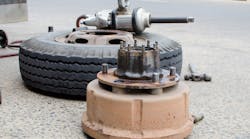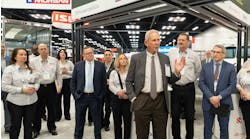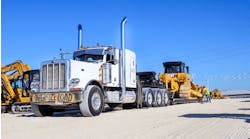Fleets should not use vendors that fail to follow RIST (remove debris, inspect the components, snug the lug nuts, and torque to spec) when installing tire and rim assemblies.
Mistakes in the truck tire and wheel industry can be costly. Something as simple as inflation pressure will stop a vehicle in its tracks when the tractor or trailer cannot support the load. And while overinflation would appear to be the lesser of two evils, it reduces tire mileage and increases the chance of an impact break. On the other hand, when the inflation pressure inside the tire is sufficient for the load, there is still no guarantee that there won’t be any issues. There are simply too many variables.
See also: Saving with tire section repairs
Wheel installation is another area where a simple solution like inflation pressure would appear to prevent loose wheels. For decades, people have assumed that proper torque is like proper inflation pressure in the sense that it solves most of problems. But conditions associated with the operation of a commercial motor vehicle affect multiple components, and wheel torque, like inflation pressure, offers no guarantees when it’s correct.
Before diving into the multiple ways that the proper torque can still result in loose wheels, the age-old practice of “good and tight” must be addressed.
There are far too many truck tire service providers who use a standard impact wrench to tighten lug nuts. In most instances, the excessive torque they impose does not result in broken or fatigued studs because modern hub-piloted wheel systems are far more durable than their stud-piloted, or Budd, wheel counterparts. However, if the overtorquing is severe enough, it can and will result in wheel issues when one or more of the studs fail. At best, the good-and-tight method ensures nothing is loose after the vehicle returns to service, but problems may surface miles down the road.
In the event of a wheel-off accident that results in property damage or personal injury, the method used to install the wheel or wheels will come into question.
Plaintiffs have a field day with “good and tight” because there is virtually no way that the installer can say with any degree of certainty that the torque during installation was correct. The best that can be said is nothing was loose when it left the shop or the side of the road. Juries are unlikely to show any sympathy for the installer, who has no idea how much torque was applied to the fasteners. They won’t think kindly of the fleet, either.
See also: Bridgestone installing tire monitoring technology at 200 Pilot locations
The commercial tire service industry has come a long way with wheel torque programs. More of them understand that while important, the torque wrench is not a magic wand that guarantees that wheels stay attached to the end of the axle. It’s a “program” because it addresses four specific areas where torque is the final step. When I was asked to create an acronym for rim and wheel installation almost 20 years ago, I never expected it to become the standard.
Fleets should not use vendors that fail to follow the RIST procedure when installing tire and rim assemblies. The “R” stands for removing debris from mating surfaces so the joint does not settle during service. Foreign material between the wheel and hub or between duals can lead to loose wheels, and this is impossible to defend. The “I” stands for inspect the components. Damaged or worn fasteners, bolt holes, and rim/wheel surfaces must be replaced. Substandard components are difficult to defend. The “S” stands for snug, as in snug the fasteners in a star pattern to seat the wheel or wheels on the end of the axle. And the final step in the process is “T,” which obviously stands for applying the correct torque.
Together, the steps in RIST represent the absolute best chance for success wheels are installed. It’s also relatively easy to defend if all the pieces are in place consistently. The service side is getting better, and torque control devices are used far more regularly than they were in the past. More important, high-quality vendors recognize that torque is only part of the equation, so equal attention is given to the other three steps of RIST.
Clamping force is the key factor when installing wheels, and it cannot be measured in the field. When the correct torque is used as part of the RIST procedure to gauge the proper clamping force, loose wheels are rare. When the correct torque is used but the other three steps aren’t followed, the chance of wheel-offs increases. And when the installer has no idea how much torque is being applied and no clue about RIST, it’s an accident waiting to happen.
Kevin Rohlwing is the SVP of training for the Tire Industry Association. He has more than 39 years of experience in the tire industry and has created programs to help train more than 180,000 technicians.



